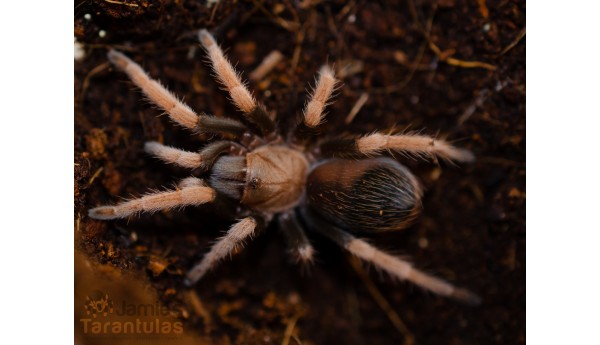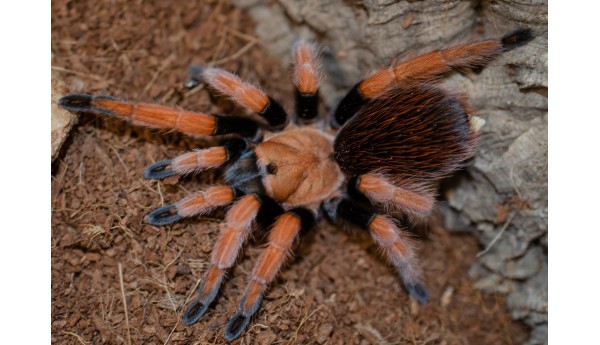Aphonopelma bicoloratum (Mexican Blood-Leg) 1 1/4 - 1 1/2" MALE #BCS-1
A sibling to BCS-1 is pictured first. A sub-adult os pictured second. At about five years old she is just starting to show adult color. Each molt her red-orange will get brighter, and her blacks darker. In my opinion this is the best time to get a tarantula to raise up.
This beautiful and unique New World is known for its docile and hardy nature. These well started slings are just beginning to show the first signs of adult color. It is a perfect time to witness the transformation! These lovely little slings are not out of reach for an attentive beginner and would be a great choice for intermediate and above keepers looking for someone as unique and amazing as the Mexican Blood Leg!
They are currently feeding on medium pinhead B. lateralis roaches. We recommend housing in a terrestrial juvenile or Mag-Terra terrestrial.
These spiderlings are extremely limited!
This beautiful and unique New World is known for its docile and hardy nature. Often confused with Brachypelma boehmei due to similar markings, this Aphonopelma is quite different indeed.
Quite uncommon in the hobby the species is known for it's bright coloring, longevity, hardiness and docile nature. A. bicoloratum also has a reputation for being quite a slow-growing species but, good things come to those who wait. I found watching the species grow from a little brown speck to a vibrant orange marvel to be one of the most rewarding in the hobby.
This heavy bodied tarantula is typically slower-moving as well. Smaller slings like to burrow while larger specimens are often content to adopt a hide, and are more likely to be out in the open for viewing. A true display spider the species is a favorite among veteran hobbyists and beginners alike.
Origin: New World. Native to Mexico
Difficulty: Beginner
Type: Terrestrial
Adult Size: 4.5-5"
Growth speed: Very slow
Longevity: Males 7+ years, females 26-40+ years
Temperament: Known for it's docile nature if frightened or disturbed it may flee and/or flick urticating hairs. Bites from this species are very rare.
Bite potency: Mild
Urticating hairs: Yes
Ideal Temperature: 70 to 75°
Humidity: Low to Medium
Fun Fact: I often get questions asking for comparisons on the two and although A.bicoloratum is often compared to B. boehmei (due to similar coloration) the two are not as closely related as many might think. They're not even in the same genus!
I feel A. bicoloratum tend to be heavier/stockier for their size although B. boehmei do get larger overall. B. boehmei have distinct yellow bands on their legs which the A. bicoloratum lack. Adult B. boehmei tend to be dark red in color while the A. bicoloratum are vibrant orange.
The biggest difference I think for hobbyists is the personality of the two. Although both can make a great beginner tarantula the A. bicoloratum tend to be less much less likely to flick urticating hairs when disturbed for rehousing or shipping.
Enclosure: For spiderlings under about 1/3-1 1/4" we recommend the Terrestrial Spiderling Enclosure Kit. For specimens over 1" to about 2" we recommend the Terrestrial Juvenile Enclosure Kit. Specimens over 2" can go into a7x7x11" complete terrestrial enclosure or 8x8x14" Adult Complete Terrestrial . Click HERE to find out how to you measure a tarantula.
Substrate: While most adults will adopt a hide, slings often prefer to burrow. Cocofiber, vermiculite, peat moss and/or potting soil (or a mix) are all excellent substrate choices. Please make sure the substrate you choose is organic and chemical/fertilizer free. Do not use sand, pebbles, rocks or wood chips or anything else that could potentially cut or injure the tarantula.
In many cases a larger specimen would rather adopt or retrofit an existing hide than create it's own from deep substrate.Cork tubes half buried in substrate are what we use for our adult females. The specimen will excavate one side of the cork tube to it's liking. I like to think this makes the tarantula feel “at home” while minimizing the time and effort for the spider to settle in.
Spiderlings will often desire to create their own home by excavating a burrow. A tarantula with this talent and preference for tunneling is referred to as an obligate burrower. To encourage this natural behavior we recommend rehousing on semi-moist substrate at least twice, and ideally three times as deep as the tarantulas DLS. The substrate and should dry out as needed. The Terrestrial Spiderling and Terrestrial Juvenile Enclosure Kit can be set up to encourage burrowing. Older/larger specimens are typically kept with hides as they're more likely to be observed.
Water: Larger spiders 2” and over can be provided with a shallow water dish if desired. The water bowl should be rinsed our every time it is refilled. Being a scrubland species they will not require as frequent misting.
Feeding: Adults will eat every 10-18 days depending on the size of the spider and it's prey. Spiderlings should eat more often, every 7-14 days. Adults may be fed crickets, mealworms or roaches. Spiderlings under 1/3” can only eat food small enough for it to overpower so it may be advised to use pre-killed four until large enough to handle live prey. We feed our slings freshly hatched "pinhead" rusty red roaches.
Keep your tarantulas enclosure clean. food waste left in the enclosure will invite mold, mildew, mites, flies and other pests. The substrate does not need to be changed unless it is moldy, overly filthy or otherwise unfit for the tarantula. It is advised to remove uneaten prey items after a few minutes to hours. If using a feeder who will not “bother” a tarantula such as dubia roaches it is alright to leave them in the enclosure as long as they are not causing stress to the specimen. A more detailed feeding, misting & troubleshooting guide can be found here: https://jamiestarantulas.com/guides/
- $59.00 $175.00
- In Stock
Tarantula Care
Lorem ipsum dolor sit amet, consectetur adipiscing elit. Vivamus ultricies leo gravida purus facilisis eleifend at vitae eros. Nam vehicula lorem dignissim tortor euismod luctus. Mauris non consectetur dolor. Vivamus ut neque tempor enim hendrerit viverra eu et tellus. Curabitur ac volutpat mi. Vivamus congue ipsum et turpis consequat pellentesque. Vestibulum ante ipsum primis in faucibus orci luctus et ultrices posuere cubilia Curae.
Lorem ipsum dolor sit amet, consectetur adipiscing elit. Vivamus ultricies leo gravida purus facilisis eleifend at vitae eros. Nam vehicula lorem dignissim tortor euismod luctus. Mauris non consectetur dolor. Vivamus ut neque tempor enim hendrerit viverra eu et tellus. Curabitur ac volutpat mi. Vivamus congue ipsum et turpis consequat pellentesque. Vestibulum ante ipsum primis in faucibus orci luctus et ultrices posuere cubilia Curae.
Tarantula Tips
Lorem ipsum dolor sit amet, consectetur adipiscing elit. Vivamus ultricies leo gravida purus facilisis eleifend at vitae eros. Nam vehicula lorem dignissim tortor euismod luctus. Mauris non consectetur dolor. Vivamus ut neque tempor enim hendrerit viverra eu et tellus. Curabitur ac volutpat mi. Vivamus congue ipsum et turpis consequat pellentesque. Vestibulum ante ipsum primis in faucibus orci luctus et ultrices posuere cubilia Curae.
Lorem ipsum dolor sit amet, consectetur adipiscing elit. Vivamus ultricies leo gravida purus facilisis eleifend at vitae eros. Nam vehicula lorem dignissim tortor euismod luctus. Mauris non consectetur dolor. Vivamus ut neque tempor enim hendrerit viverra eu et tellus. Curabitur ac volutpat mi. Vivamus congue ipsum et turpis consequat pellentesque. Vestibulum ante ipsum primis in faucibus orci luctus et ultrices posuere cubilia Curae.






